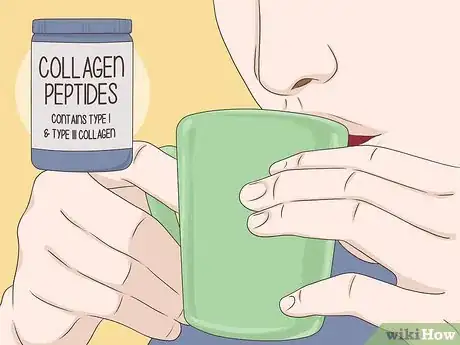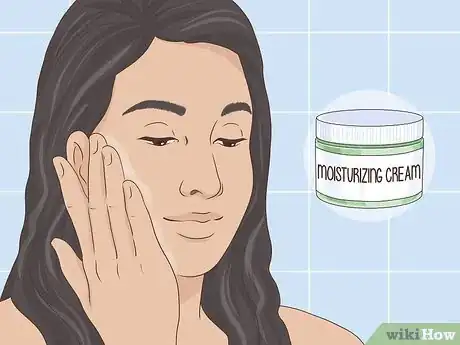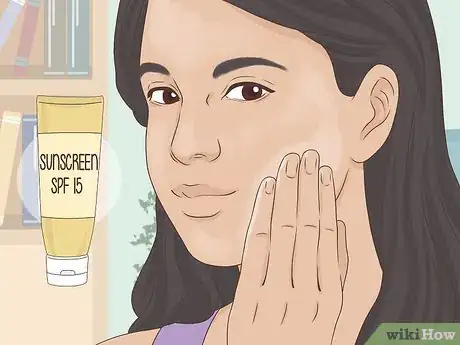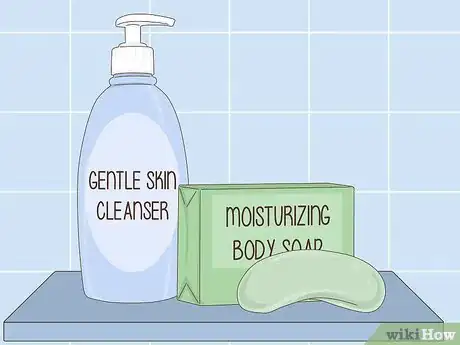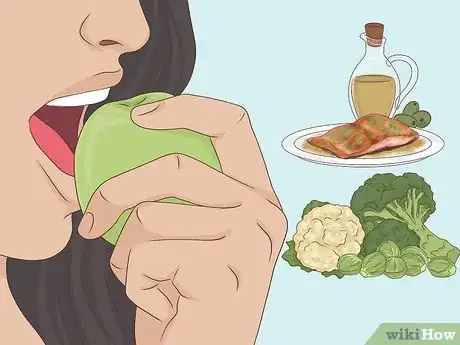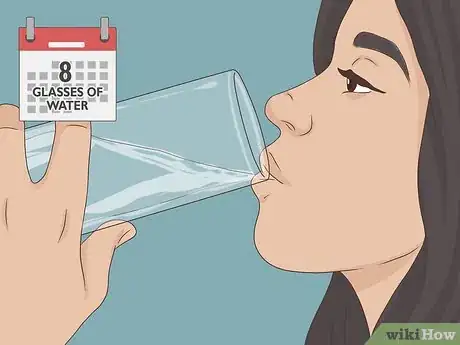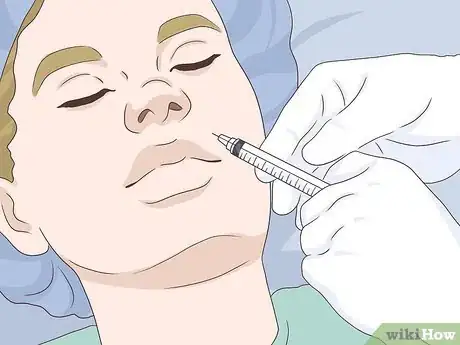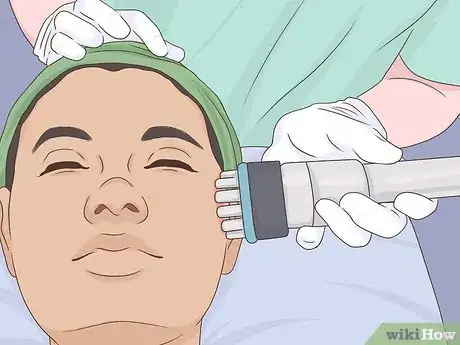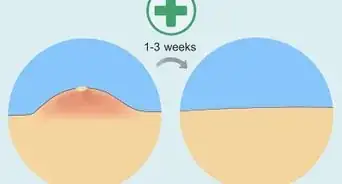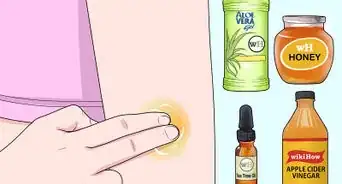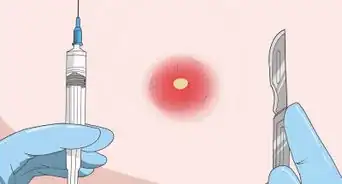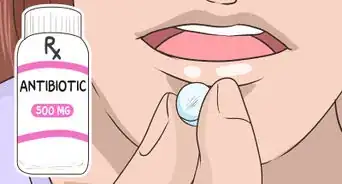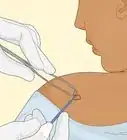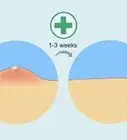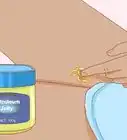This article was co-authored by Mohiba Tareen, MD. Mohiba Tareen is a board certified Dermatologist and the founder of Tareen Dermatology located in Roseville, Maplewood and Faribault, Minnesota. Dr. Tareen completed medical school at the University of Michigan in Ann Arbor, where she was inducted into the prestigious Alpha Omega Alpha honor society. While a dermatology resident at Columbia University in New York City, she won the Conrad Stritzler award of the New York Dermatologic Society and was published in The New England Journal of Medicine. Dr. Tareen then completed a procedural fellowship which focused on dermatologic surgery, laser, and cosmetic dermatology.
There are 18 references cited in this article, which can be found at the bottom of the page.
This article has been viewed 11,282 times.
If you’ve noticed that your skin is getting thinner, you might be feeling upset and concerned that it could get worse, which is completely understandable. Whether it’s caused by an underlying condition or just as a natural part of getting older, nobody wants thinning skin. But don’t worry. There are plenty of things can try at home as well as with the help of your doctor or dermatologist to treat the issue and keep your skin protected. There are also long term lifestyle changes you make to improve the health of your skin.
Steps
Using Supplements
-
1Use topical vitamin C creams to treat skin changes caused by aging. Studies suggest that topical vitamin C can be used to treat and prevent skin changes caused by getting older.[1] Apply a vitamin C serum in the morning before you apply moisturizer or sunscreen to help repair damage and collagen loss.[2]
- It can take between 6-8 weeks for you to notice significant changes.
- Look for vitamin C serums at beauty supply stores. You can also order them online.
-
2Try evening primrose oil supplements to improve your skin. Evening primrose oil (EPO) contains gamma-linolenic acid (GLA), which has been shown to improve skin moisture, elasticity, and firmness.[3] Take evening primrose supplements or a GLA supplement to help treat skin changes caused by aging.
- Follow the dosing instructions on the supplement label. Recommended dosages of GLA supplements are between 200-500 mg a day.[4]
Advertisement -
3Take collagen peptide supplements to improve your skin’s health. Collagen peptide supplements can improve skin elasticity and skin moisture levels, which can help rejuvenate your skin.[5] Take collagen peptides according to the directions on the supplement packaging.
- Studies show that taking between 2.5-5 g of collagen peptide supplements once a day for 8 weeks showed significant skin improvements.[6]
- Collagen peptide supplements may not have any side effects as well.
- Look for supplements at your local vitamin shop. You can also order them online.
-
4Apply prescription topical retinoids to boost collagen production. Retinoids can help boost your skin’s collagen levels which can plump and rejuvenate your skin.[7] Talk to your doctor about topical retinoids and ask for a prescription. Your doctor will let you know if retinoids are safe for you.
- Retinoids are topical vitamin A-based creams, and they help increase cell turnover.[8]
- Some skincare products contain small amounts of retinoids, but your doctor can give a prescription for a much stronger version.
Protecting Your Skin
-
1Moisturize your skin regularly and immediately after bathing. When you get out of a bath or shower, your skin is still porous, which allows it to better absorb moisturizers. Within 2 minutes of getting out of the water, apply a hydrating, cream-based moisturizer to help lock moisture into your skin and keep it from drying out.[9]
- Dry skin can cause cracks or fissures to form in your skin, so it’s super important that you moisturize it often.[10]
- Keeping your skin moisturized can also help protect your skin barrier. It's important to keep your skin barrier intact as much as possible so you don't let in bacteria or allergens that can lead to inflammation and irritation.[11]
- Effective moisturizing creams include Vanicream, CeraVe, and Cetaphil.
-
2Wear long-sleeved shirts and long pants. Thinner skin can be more at risk of bruises and tears. Put on a long-sleeved shirt and wear long pants to help prevent cuts and tears on your arms and legs.[12]
- You may want to wear 2 layers of clothes if you’re doing tasks such as yard work or gardening just to be extra safe.
- You could also wrap gauze bandages around your forearms for extra protection.
-
3Avoid scratching dry and itchy skin. If your skin feels itchy or dry, apply some hydrating moisturizer. Scratching can damage and traumatize your skin, so try to avoid it at all costs.[13]
-
4Use sunscreen with an SPF of 15 or higher when you go outside. Exposure to ultraviolet (UV) light from the sun can damage your skin and cause it to age more quickly. If you plan to go out in the sun, always apply sunscreen to cover your entire face and body.[14]
- Reapply sunscreen every 2 hours, or more often if you’re sweating or swimming to keep your skin protected.
-
5Put on a broad-brimmed hat to protect your face from the sun. In addition to sunscreen, a broad-brimmed cap can provide some further protection for the sensitive skin on your face. Before you head out into the sun, put on a cap with a brim wide enough to cover your face.[15]
- An extra-wide brim can also help protect your neck as well.
Keeping Your Skin Healthy
-
1Take shorter showers and use lukewarm water. Use quick, 5-minute baths and showers to clean and hydrate your skin. Hot water can strip your skin of its natural oils, so keep the water warm but not too hot.[16]
- Avoid staying in the water for more than 10 minutes or it can start to leach moisture out of your skin.
-
2Choose gentle skin cleansers and soaps. Whenever you bathe or shower, avoid harsh cleansers and abrasive soaps. Clean your skin gently with products designed for sensitive skin instead.[17]
- Avoid washcloths or abrasive brushes as well.
- Consider only using soap in the areas where you really need it, like under your armpits, between your toes, around your groin, and under your breasts.[18]
-
3Use a humidifier at home if you live in a dry climate. Dry air can dry out your skin and cause it to age more quickly. If you live an area with especially dry air use a humidifier to increase the moisture levels in the air of your home.[19]
- You can find humidifiers at your local department store. You can also order them online.
-
4Eat a well-balanced diet to give your body the nutrition it needs. Your skin’s health is very much connected to your overall physical health, so a healthy diet is really important.[20] Make sure you eat a healthy balance of lean protein, healthy fats, whole grains, and lots of fruits and veggies to help make sure your skin is nourished.
- Avoid processed and fatty foods.
- Focus on healthy sources of fat like olive oil and avocado.
- Grab a tasty piece of fruit instead of a salty snack if you need something to munch on.
-
5Drink at least 8 glasses of water each day. Drinking plenty of water each day will help rid your body and skin of toxins and can help keep your skin hydrated. Focus on drinking enough water each day to make your skin healthier and more radiant.[21]
- If your skin is more hydrated and moisturized, it may not dry out or break as much.
-
6Quit smoking to improve your skin’s health. Smoking causes many other medical issues, but it can also reduce blood flow and cause your skin to age more quickly. If you currently smoke, try quitting as soon as possible to improve your thinning skin and your overall health.[22]
Medical Treatments
-
1Boost your natural collagen levels with microneedling. Microneedling is a medical procedure that uses a hand roller with hundreds of fine needles to puncture your skin, which stimulates a healing response that can boost your collagen levels and thicken your skin. Talk to your doctor or dermatologist about having a microneedling procedure and make an appointment to have the procedure done by a medical professional.[23]
-
2Stimulate new collagen on your face with volumizing injections. Volumizing injections use chemicals to help combat thin skin and stimulate new collagen, or act as a substitute for lost collagen. Contact your dermatologist to schedule injections that can help treat your thinning skin.[26]
-
3Tighten your skin with radiofrequency treatments. Radiofrequency (RF) treatments use energy to heat up your skin and stimulate more collagen which can tighten and firm up your skin. It’s been shown to be an effective skin treatment option.[29] Talk to your dermatologist or ask your doctor for a referral to schedule an RF treatment.
Expert Q&A
Did you know you can get expert answers for this article?
Unlock expert answers by supporting wikiHow
-
QuestionWhat does retinol cream do?
 Mohiba Tareen, MDMohiba Tareen is a board certified Dermatologist and the founder of Tareen Dermatology located in Roseville, Maplewood and Faribault, Minnesota. Dr. Tareen completed medical school at the University of Michigan in Ann Arbor, where she was inducted into the prestigious Alpha Omega Alpha honor society. While a dermatology resident at Columbia University in New York City, she won the Conrad Stritzler award of the New York Dermatologic Society and was published in The New England Journal of Medicine. Dr. Tareen then completed a procedural fellowship which focused on dermatologic surgery, laser, and cosmetic dermatology.
Mohiba Tareen, MDMohiba Tareen is a board certified Dermatologist and the founder of Tareen Dermatology located in Roseville, Maplewood and Faribault, Minnesota. Dr. Tareen completed medical school at the University of Michigan in Ann Arbor, where she was inducted into the prestigious Alpha Omega Alpha honor society. While a dermatology resident at Columbia University in New York City, she won the Conrad Stritzler award of the New York Dermatologic Society and was published in The New England Journal of Medicine. Dr. Tareen then completed a procedural fellowship which focused on dermatologic surgery, laser, and cosmetic dermatology.
FAAD Board Certified Dermatologist
Warnings
- Talk to your doctor before making any sudden changes to your diet or lifestyle, as well as before trying any medications or supplements to treat your thinning skin to make sure they’re safe for you.⧼thumbs_response⧽
References
- ↑ https://www.ncbi.nlm.nih.gov/pmc/articles/PMC3673383/
- ↑ https://www.cnn.com/2019/10/15/cnn-underscored/vitamin-c-benefits-for-skin/index.html
- ↑ https://pubmed.ncbi.nlm.nih.gov/18492193/
- ↑ https://www.winchesterhospital.org/health-library/article?id=21587
- ↑ https://pubmed.ncbi.nlm.nih.gov/23949208/
- ↑ https://pubmed.ncbi.nlm.nih.gov/23949208/
- ↑ https://www.ncbi.nlm.nih.gov/pmc/articles/PMC3583892/
- ↑ Mohiba Tareen, MD. FAAD Board Certified Dermatologist. Expert Interview. 26 March 2020.
- ↑ Mohiba Tareen, MD. FAAD Board Certified Dermatologist. Expert Interview. 26 March 2020.
- ↑ https://www.mayoclinic.org/healthy-lifestyle/healthy-aging/expert-answers/thin-skin/faq-20057753
- ↑ Mohiba Tareen, MD. FAAD Board Certified Dermatologist. Expert Interview. 26 March 2020.
- ↑ https://www.mayoclinic.org/healthy-lifestyle/healthy-aging/expert-answers/thin-skin/faq-20057753
- ↑ https://health.usnews.com/health-care/patient-advice/articles/2017-09-27/paper-thin-skin-care-for-seniors
- ↑ https://www.fda.gov/drugs/understanding-over-counter-medicines/sunscreen-how-help-protect-your-skin-sun
- ↑ https://www.fda.gov/drugs/understanding-over-counter-medicines/sunscreen-how-help-protect-your-skin-sun
- ↑ https://www.health.harvard.edu/staying-healthy/8-tips-to-protect-and-preserve-aging-skin
- ↑ https://health.usnews.com/health-care/patient-advice/articles/2017-09-27/paper-thin-skin-care-for-seniors
- ↑ Mohiba Tareen, MD. FAAD Board Certified Dermatologist. Expert Interview. 26 March 2020.
- ↑ https://health.usnews.com/health-care/patient-advice/articles/2017-09-27/paper-thin-skin-care-for-seniors
- ↑ https://www.ncbi.nlm.nih.gov/pmc/articles/PMC3583891/
- ↑ https://www.uwhealth.org/madison-plastic-surgery/the-benefits-of-drinking-water-for-your-skin/26334
- ↑ https://www.health.harvard.edu/staying-healthy/8-tips-to-protect-and-preserve-aging-skin
- ↑ https://www.health.harvard.edu/staying-healthy/needling-your-way-to-healthier-skin
- ↑ https://www.express.co.uk/life-style/health/612079/Banish-thin-skin-plump-up-volume
- ↑ https://www.express.co.uk/life-style/health/612079/Banish-thin-skin-plump-up-volume
- ↑ https://www.health.harvard.edu/newsletter_article/Dermal_fillers_Caulking_the_lines_of_time
- ↑ https://www.express.co.uk/life-style/health/612079/Banish-thin-skin-plump-up-volume
- ↑ https://www.express.co.uk/life-style/health/612079/Banish-thin-skin-plump-up-volume
- ↑ https://www.ncbi.nlm.nih.gov/pmc/articles/PMC4631236/
- ↑ https://www.express.co.uk/life-style/health/612079/Banish-thin-skin-plump-up-volume#
- ↑ https://www.express.co.uk/life-style/health/612079/Banish-thin-skin-plump-up-volume
- ↑ https://health.usnews.com/health-care/patient-advice/articles/2017-09-27/paper-thin-skin-care-for-seniors
- ↑ https://health.usnews.com/health-care/patient-advice/articles/2017-09-27/paper-thin-skin-care-for-seniors


